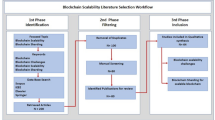Abstract
Consortium blockchain has been widely used in finance, e-government due to the characteristics of controllability, supervision, and operability. However, traditional consortium blockchains have bottlenecks in throughput. To solve the bottlenecks, the paper proposes a Dynamic Sharding Model and Performance Optimization Method for Consortium Blockchain (DSPO-CB), which offers a new shard architecture and dynamically optimizes the architecture through the Deep Q-Network (DQN). Firstly, the model reduces redundancy and improves space utilization by classifying the nodes ensuring security. Secondly, the model proposes the shard structure through a dynamic clustering method based on the node status to reduce the proportion of cross-shard transactions. Finally, the DQN is used to dynamically optimize the sharding and consensus architecture. Experiments show that DSPO-CB improves the throughput by 33% and saves up to 78% storage space compared with the existing consortium blockchain.













Similar content being viewed by others
References
Dib O, Brousmiche K-L, Durand A, Thea E, Hamida EB (2018) Consortium blockchains: overview, applications and challenges. Int J Advan Telecommun 11(1 &2):51–64
Shen T, Li T, Yu Z, Bai F, Zhang C (2023) GT-NRSM: efficient and scalable sharding consensus mechanism for consortium blockchain. J Supercomput 79(17):20041–20075
Tian Z, Li M, Qiu M, Sun Y, Su S (2019) Block-def: a secure digital evidence framework using blockchain. Inf Sci 491:151–165
Pu Y, Xiang T, Hu C, Alrawais A, Yan H (2020) An efficient blockchain-based privacy preserving scheme for vehicular social networks. Inf Sci 540:308–324
Wu C, Amiri MJ, Asch J, Nagda H, Zhang Q, Loo BT (2022) Flexchain: an elastic disaggregated blockchain. Proc VLDB Endow 16(1):23–36
Huang B, Jin L, Lu Z, Zhou X, Wu J, Tang Q, Hung PC (2019) Bor: toward high-performance permissioned blockchain in rdma-enabled network. IEEE Trans Serv Computing 13(2):301–313
Gouk D, Lee S, Kwon M, Jung M (2022) Direct access, high-performance memory disaggregation with directcxl. USENIX ATC, 287–294
Huang Y, Huang Y, Yan M, Hu J, Liang C, Xu Y, Zou W, Zhang Y, Zhang R, Huang C, Wu J (2022) An ultra-low latency and compatible pcie interconnect for rack-scale communication. CoNEXT, 232–244
Pan J, Huang D (2020) Blockchain dynamic sharding model based on jump hash and asynchronous consensus group. Comput Sci 47(3):273–280
Zhou Z, Qiu Z, Yu Q, Chen H (2020) A dynamic sharding protocol design for consortium blockchains. In: 2020 IEEE International Conference on Big Data (Big Data), pp. 2590–2595. IEEE
Li L, Wu Y, Yang Z, Chen Y (2022) Medical electronic record sharing scheme based on sharding-based blockchain. J Comput Appl 42(1):183
Zheng P, Xu Q, Zheng Z, Zhou Z, Yan Y, Zhang H (2021) Meepo: Sharded consortium blockchain. In: 2021 IEEE 37th International Conference on Data Engineering (ICDE), pp. 1847–1852. IEEE
Cheng F, Xiao J, Liu C, Zhang S, Zhou Y, Li B, Li B, Jin H (2024) Shardag: scaling dag-based blockchains via adaptive sharding. ICDE 2024:2068–2081
Xu J, Ming Y, Wu Z, Wang C, Jia X (2024) X-shard: optimistic cross-shard transaction processing for sharding-based blockchains. IEEE Trans Parallel Distributed Syst 35(4):548–559
Xu Z, Tang J, Meng J, Zhang W, Wang Y, Liu CH, Yang D (2018) Experience-driven networking: A deep reinforcement learning based approach. In: IEEE INFOCOM 2018-IEEE Conference on Computer Communications, pp. 1871–1879. IEEE
Mnih V, Kavukcuoglu K, Silver D, Rusu AA, Veness J, Bellemare MG, Graves A, Riedmiller M, Fidjeland AK, Ostrovski G et al (2015) Human-level control through deep reinforcement learning. Nature 518(7540):529–533
Huang D, Ma X, Zhang S (2019) Performance analysis of the raft consensus algorithm for private blockchains. IEEE Trans Syst Man Cybern: Syst 50(1):172–181
Yun J, Goh Y, Chung J-M (2020) Dqn-based optimization framework for secure sharded blockchain systems. IEEE Internet of Things J 8(2):708–722
Geng T, Du Y (2022) Applying the blockchain-based deep reinforcement consensus algorithm to the intelligent manufacturing model under internet of things. The Journal of Supercomput 78:15882–15904
Duong T, Fan L, Veale T, Zhou H-S (2016) Securing bitcoin-like backbone protocols against a malicious majority of computing power. IACR Cryptol. ePrint Arch. 2016:716
Baek J, Zheng Y (2004) Identity-based threshold signature scheme from the bilinear pairings. In: International Conference on Information Technology: Coding and Computing, 2004. Proceedings. ITCC 2004., vol. 1, pp. 124–128. IEEE
Nan C, Shengli L (2021) Message authentication codes against related-key attacks under lpn and lwe. Chin J Electron 30(4):697–703
Lamport L, Shostak R, Pease M (2019) The byzantine generals problem. In: Concurrency: the Works of Leslie Lamport, pp. 203–226
Schaul T, Quan J, Antonoglou I, Silver D (2015) Prioritized experience replay. arXiv preprint arXiv:1511.05952
Funding
This work is supported by the National Key Research and Development Program (Grant No.2023YFC3304904), the Artificial Intelligence Technology Innovation Project of Liaoning Province (Grant No. 2023JH26/10300019), the Basic Research Project of Liaoning Provincial Department of Education for Universities, (Grant No. LJ242410140013).
Author information
Authors and Affiliations
Contributions
YW: investigation; writing review & editing (lead). ZG: writing-original draft preparation; software; methodology; validation; writing review (equal). DJ: software; reviewing (equal). AT: methodology; investigation(equal). ML: discussion; reviewing (equal).
Corresponding author
Ethics declarations
Conflict of interest
The authors have no relevant financial or non-financial interests to disclose.
Ethical Approval
Not applicable.
Additional information
Publisher's Note
Springer Nature remains neutral with regard to jurisdictional claims in published maps and institutional affiliations.
Rights and permissions
Springer Nature or its licensor (e.g. a society or other partner) holds exclusive rights to this article under a publishing agreement with the author(s) or other rightsholder(s); author self-archiving of the accepted manuscript version of this article is solely governed by the terms of such publishing agreement and applicable law.
About this article
Cite this article
Wang, Y., Gong, Z., Jia, D. et al. Dynamic sharding model and performance optimization method for consortium blockchain. J Supercomput 81, 411 (2025). https://doi.org/10.1007/s11227-024-06870-8
Accepted:
Published:
DOI: https://doi.org/10.1007/s11227-024-06870-8




